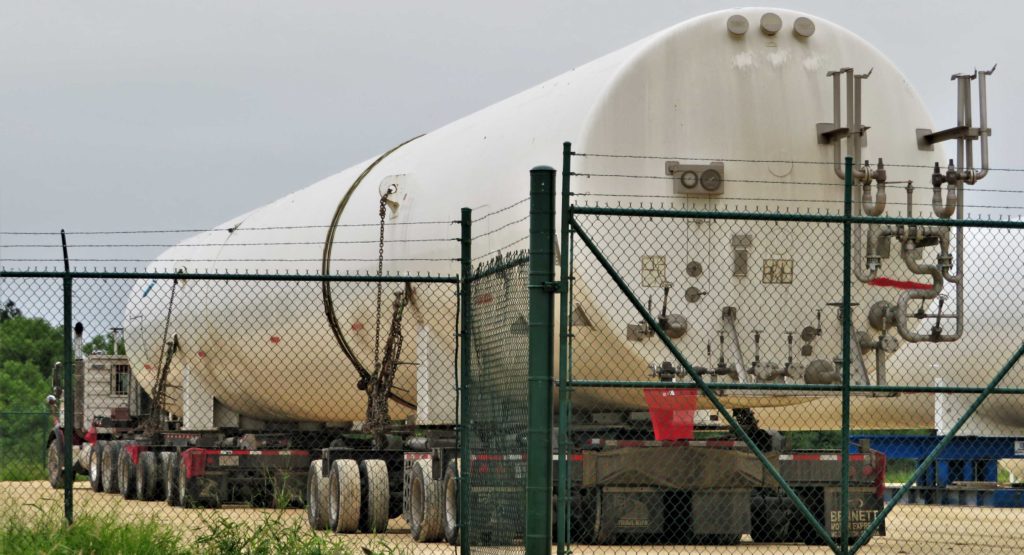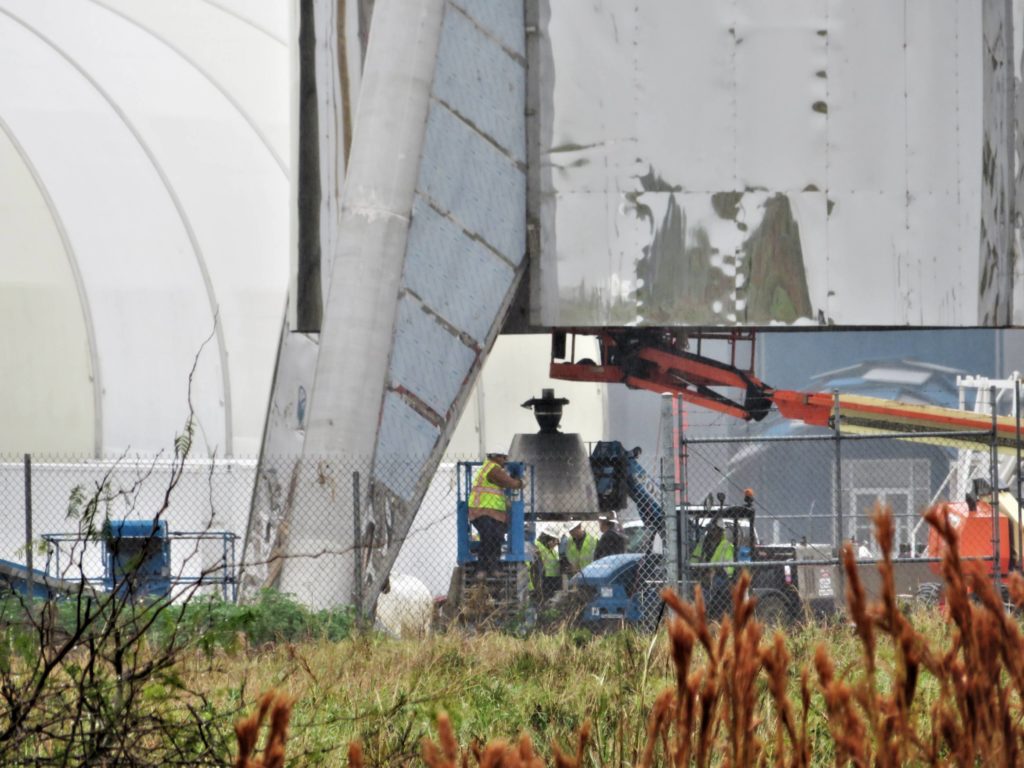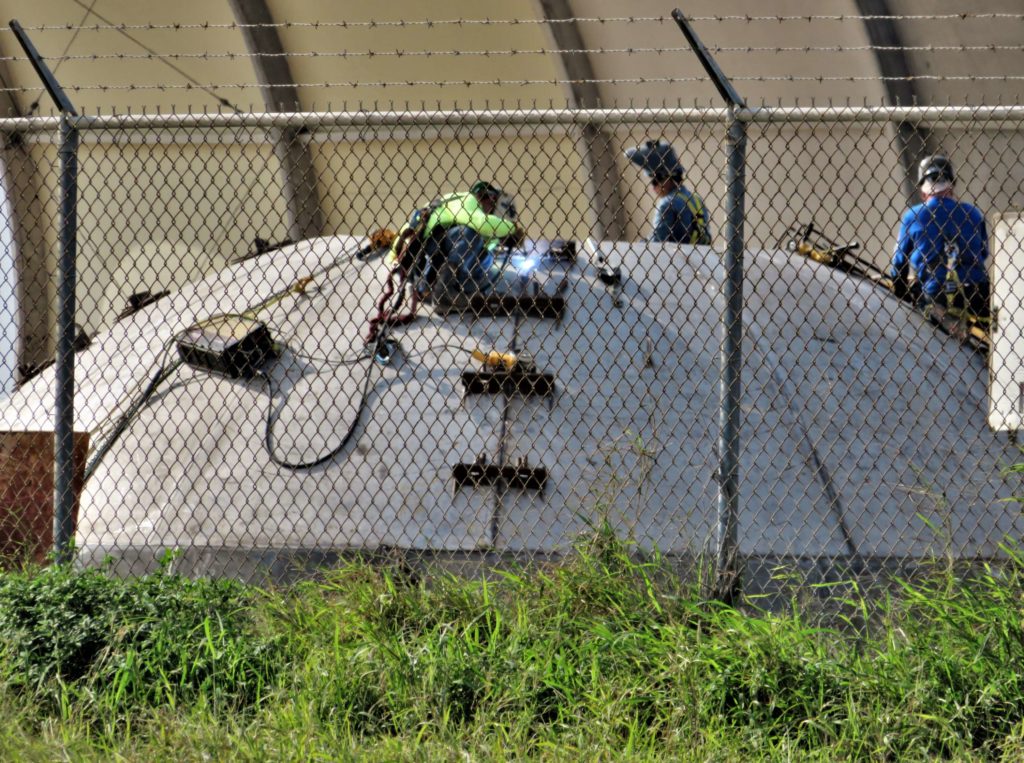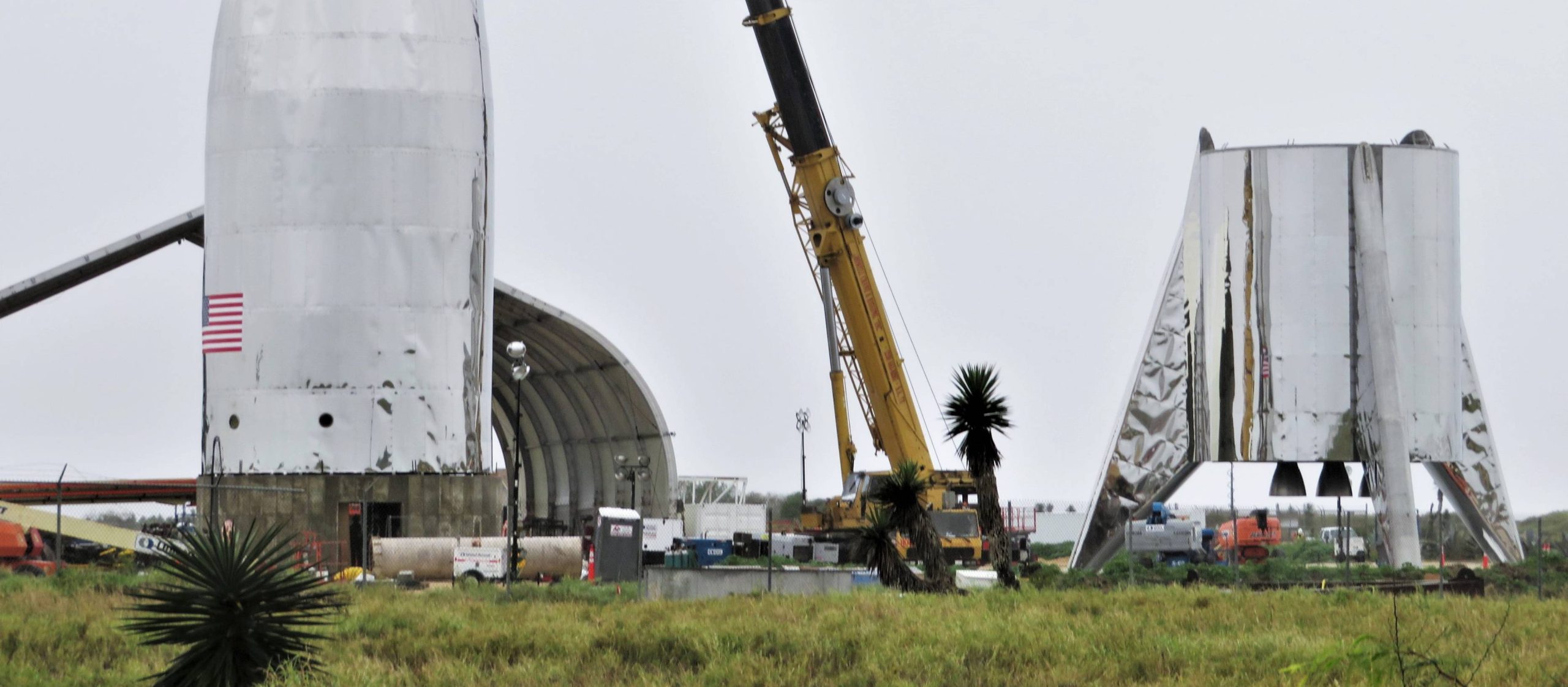
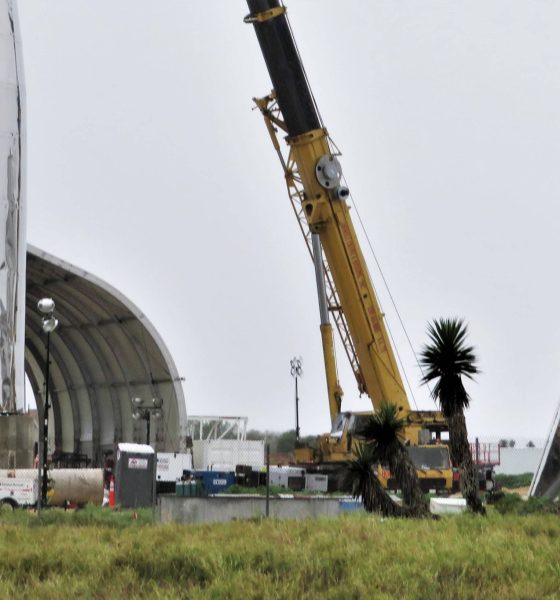
News
SpaceX separates Starship prototype’s nose and tail to install giant propellant tanks
After a handful of days as an impressive monolith stood along the coastal wetlands of Texas, SpaceX technicians have once again separated the nose and tail sections of the first Starship prototype to allow additional integration and assembly work to continue. The craft’s three Raptors were also removed and stored nearby, shown to be barebones facsimiles standing in for flightworthy hardware that could arrive in the next month or two.
Up next, three or four propellant tank domes – currently being assembled and welded together on-site – will likely be installed inside the steel hull of the giant Starship prototype’s aft barrel section. Known as bulkheads, the installation of those tank domes will bring SpaceX one step closer to performing hop tests of the simultaneously bizarre, confusing, and beautiful craft.
Starship Hopper has been taken apart again (for the installation of the bulkhead etc.)
📸NSF's BocaChicaGalhttps://t.co/DlTj9Qiijz
NSF Overview News Article by Thomas Burghardt @TGMetsFan98 for those catching up:https://t.co/rgliFAkBMC pic.twitter.com/DzSJzjSvoI
— NSF – NASASpaceflight.com (@NASASpaceflight) January 15, 2019
At this point in time, it appears that Starhopper is some odd combination of showmanship and actual hardware meant to test certain aspects of the first orbital Starship build, said to be complete as early as June 2019 by CEO Elon Musk. In the last week or so, SpaceX technicians attached and welded over Starhopper’s two sections – an aft barrel with legs and Raptors and a conical nose – and even did a sort of photoshoot, removing an on-site fence for a photo that Musk later shared while stating that the vehicle had “completed assembly”.
Starship test flight rocket just finished assembly at the @SpaceX Texas launch site. This is an actual picture, not a rendering. pic.twitter.com/k1HkueoXaz
— Elon Musk (@elonmusk) January 11, 2019
One could argue that assembly is not exactly complete if the given product has to be pulled in half to install significant new components. Regardless, the external skin, aft barrel section, and rough landing legs do appear to be more or less complete from a very basic structural perspective, although there is clearly much work still to be done if the vehicle’s tank bulkheads haven’t been installed. Aside from completing the liquid oxygen and methane tank structure, SpaceX engineers and technicians will additionally have to complete the vehicle’s aft section, a massive 9m/30ft-diameter thrust structure capable of supporting the thrust of three Raptor engines and the weight of the entire fueled rocket. After that, plumbing, avionics, sensors, attitude thrusters, and more will still need to be completed and integrated.
If Starhopper’s nose section is largely a nonfunctioning aerodynamic shroud and propellant tanks will be primarily located inside the aft section, the fuel and oxidizer capacities of the vehicle’s tanks can be roughly estimated. Assuming a 9m/30ft diameter, the aft barrel stands around 13m/43ft tall. Assuming that the upper tank dome will reach a meter or two above the steel cylinder and that the aft Raptor thrust structure is also roughly 1-2 meters deep, Starhopper would have a total tank volume around 830 m3 or almost 30,000 cubic feet (~225,000 gallons), potentially 1000 metric tons of fuel or more if fully loaded.
SpaceX ships another huge propellant tank to South Texas BFR test sitehttps://t.co/4L7f74gwg3 pic.twitter.com/KnHXOTCfAR
— TESLARATI (@Teslarati) October 24, 2018
- SpaceX has two of these tanks and two others that are smaller but still massive. (NASASpaceflight – bocachicagal, 10/23/18)
- Starhopper’s Raptor facsimiles were removed on January 15th. (NASASpaceflight – bocachicagal)
- Meanwhile, giant 9m-diameter tank domes are being assembled and welded together a few hundred feet away from Starhopper. (NSF – bocachicagal)
Perhaps less than coincidentally, SpaceX already has liquid methane and oxygen tanks on-site (one is pictured above) with more than enough capacity to meet Starhopper’s potential propellant needs. However, it’s worth noting that current plans (and permissions) only show Starhopper traveling as high as 5km on flights that will last no more than 6 minutes, and CEO Elon Musk has indicated in no uncertain terms that the prototype will remain distinctly suborbital and is primarily focused on fleshing out Starship’s vertical take-off or landing (VTOL) capabilities before SpaceX proceeds to much more aggressive tests.
While it would be safe to take his schedule with many dozens of grains of salt, Musk noted last week that the first orbit-ready Starship could be finished as early as June 2019, while he expects Starhopper tests to begin as early as February or March. Where exactly that orbital Starship and its Super Heavy booster partner will be built is now much less clear after SpaceX has reportedly canceled a berth lease and thus its plans to build a BFR factory in the Port of Los Angeles. Will SpaceX build a BFR factory in Texas or will it build the orbital Starship en plein air like its Starhopper predecessor? And Super Heavy? Where will all three conduct static fires, hops, or launches from?
Stay tuned as more details and photos continue to bubble up from beneath the surface.

News
Nvidia CEO Jensen Huang explains difference between Tesla FSD and Alpamayo
“Tesla’s FSD stack is completely world-class,” the Nvidia CEO said.

NVIDIA CEO Jensen Huang has offered high praise for Tesla’s Full Self-Driving (FSD) system during a Q&A at CES 2026, calling it “world-class” and “state-of-the-art” in design, training, and performance.
More importantly, he also shared some insights about the key differences between FSD and Nvidia’s recently announced Alpamayo system.
Jensen Huang’s praise for Tesla FSD
Nvidia made headlines at CES following its announcement of Alpamayo, which uses artificial intelligence to accelerate the development of autonomous driving solutions. Due to its focus on AI, many started speculating that Alpamayo would be a direct rival to FSD. This was somewhat addressed by Elon Musk, who predicted that “they will find that it’s easy to get to 99% and then super hard to solve the long tail of the distribution.”
During his Q&A, Nvidia CEO Jensen Huang was asked about the difference between FSD and Alpamayo. His response was extensive:
“Tesla’s FSD stack is completely world-class. They’ve been working on it for quite some time. It’s world-class not only in the number of miles it’s accumulated, but in the way it’s designed, the way they do training, data collection, curation, synthetic data generation, and all of their simulation technologies.
“Of course, the latest generation is end-to-end Full Self-Driving—meaning it’s one large model trained end to end. And so… Elon’s AD system is, in every way, 100% state-of-the-art. I’m really quite impressed by the technology. I have it, and I drive it in our house, and it works incredibly well,” the Nvidia CEO said.
Nvidia’s platform approach vs Tesla’s integration
Huang also stated that Nvidia’s Alpamayo system was built around a fundamentally different philosophy from Tesla’s. Rather than developing self-driving cars itself, Nvidia supplies the full autonomous technology stack for other companies to use.
“Nvidia doesn’t build self-driving cars. We build the full stack so others can,” Huang said, explaining that Nvidia provides separate systems for training, simulation, and in-vehicle computing, all supported by shared software.
He added that customers can adopt as much or as little of the platform as they need, noting that Nvidia works across the industry, including with Tesla on training systems and companies like Waymo, XPeng, and Nuro on vehicle computing.
“So our system is really quite pervasive because we’re a technology platform provider. That’s the primary difference. There’s no question in our mind that, of the billion cars on the road today, in another 10 years’ time, hundreds of millions of them will have great autonomous capability. This is likely one of the largest, fastest-growing technology industries over the next decade.”
He also emphasized Nvidia’s open approach, saying the company open-sources its models and helps partners train their own systems. “We’re not a self-driving car company. We’re enabling the autonomous industry,” Huang said.
Elon Musk
Elon Musk confirms xAI’s purchase of five 380 MW natural gas turbines
The deal, which was confirmed by Musk on X, highlights xAI’s effort to aggressively scale its operations.

xAI, Elon Musk’s artificial intelligence startup, has purchased five additional 380 MW natural gas turbines from South Korea’s Doosan Enerbility to power its growing supercomputer clusters.
The deal, which was confirmed by Musk on X, highlights xAI’s effort to aggressively scale its operations.
xAI’s turbine deal details
News of xAI’s new turbines was shared on social media platform X, with user @SemiAnalysis_ stating that the turbines were produced by South Korea’s Doosan Enerbility. As noted in an Asian Business Daily report, Doosan Enerbility announced last October that it signed a contract to supply two 380 MW gas turbines for a major U.S. tech company. Doosan later noted in December that it secured an order for three more 380 MW gas turbines.
As per the X user, the gas turbines would power an additional 600,000+ GB200 NVL72 equivalent size cluster. This should make xAI’s facilities among the largest in the world. In a reply, Elon Musk confirmed that xAI did purchase the turbines. “True,” Musk wrote in a post on X.
xAI’s ambitions
Recent reports have indicated that xAI closed an upsized $20 billion Series E funding round, exceeding the initial $15 billion target to fuel rapid infrastructure scaling and AI product development. The funding, as per the AI startup, “will accelerate our world-leading infrastructure buildout, enable the rapid development and deployment of transformative AI products.”
The company also teased the rollout of its upcoming frontier AI model. “Looking ahead, Grok 5 is currently in training, and we are focused on launching innovative new consumer and enterprise products that harness the power of Grok, Colossus, and 𝕏 to transform how we live, work, and play,” xAI wrote in a post on its website.
Elon Musk
Elon Musk’s xAI closes upsized $20B Series E funding round
xAI announced the investment round in a post on its official website.

xAI has closed an upsized $20 billion Series E funding round, exceeding the initial $15 billion target to fuel rapid infrastructure scaling and AI product development.
xAI announced the investment round in a post on its official website.
A $20 billion Series E round
As noted by the artificial intelligence startup in its post, the Series E funding round attracted a diverse group of investors, including Valor Equity Partners, Stepstone Group, Fidelity Management & Research Company, Qatar Investment Authority, MGX, and Baron Capital Group, among others.
Strategic partners NVIDIA and Cisco Investments also continued support for building the world’s largest GPU clusters.
As xAI stated, “This financing will accelerate our world-leading infrastructure buildout, enable the rapid development and deployment of transformative AI products reaching billions of users, and fuel groundbreaking research advancing xAI’s core mission: Understanding the Universe.”
xAI’s core mission
Th Series E funding builds on xAI’s previous rounds, powering Grok advancements and massive compute expansions like the Memphis supercluster. The upsized demand reflects growing recognition of xAI’s potential in frontier AI.
xAI also highlighted several of its breakthroughs in 2025, from the buildout of Colossus I and II, which ended with over 1 million H100 GPU equivalents, and the rollout of the Grok 4 Series, Grok Voice, and Grok Imagine, among others. The company also confirmed that work is already underway to train the flagship large language model’s next iteration, Grok 5.
“Looking ahead, Grok 5 is currently in training, and we are focused on launching innovative new consumer and enterprise products that harness the power of Grok, Colossus, and 𝕏 to transform how we live, work, and play,” xAI wrote.
